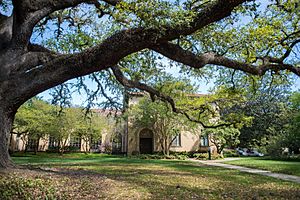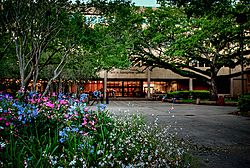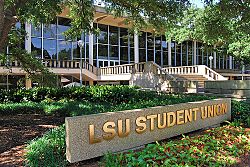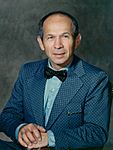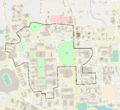Louisiana State University facts for kids
|
Louisiana State University and Agricultural and Mechanical College
|
|
 |
|
|
Former names
|
Seminary of Learning of the State of Louisiana (1853–1861) Louisiana State University Agricultural & Mechanical College (1874–1877) University of Louisiana (1913–1921) Louisiana State University (1860–1913; 1922–1963) |
|---|---|
| Type | Public land-grant research university |
| Established | January 2, 1860 |
|
Parent institution
|
Louisiana State University System |
| Accreditation | SACS |
|
Academic affiliations
|
|
| Endowment | $625.06 million (2022) |
| President | William Tate IV |
| Provost | Roy Haggerty |
|
Academic staff
|
1,500 |
|
Administrative staff
|
5,000 |
| Students | 37,354 (fall 2022) |
| Undergraduates | 31,059 |
| Postgraduates | 6,295 |
| Location |
,
,
United States
30°24′52″N 91°10′42″W / 30.4145°N 91.17826°W |
| Campus | Midsize City, 4,925 acres (1,993 ha) |
| Newspaper | The Daily Reveille |
| Colors | Purple and Gold |
| Nickname | Tigers and Lady Tigers |
|
Sporting affiliations
|
|
| Mascot | Mike the Tiger |
 |
|
|
Louisiana State University, Baton Rouge
|
|
 |
|
| Location | Highland Road, Baton Rouge |
| Area | 95 acres (38 ha) |
| Built | 1920s |
| Built by | Works Progress Administration |
| Architect | Theodore C. Link; Wogan & Bernard; Weiss, Dreyfous & Seiferth; Neild, Somdal & Neild |
| Architectural style | Italian Renaissance |
| NRHP reference No. | 88001586 (original) 100010174 (increase) |
| Significant dates | |
| Added to NRHP | September 15, 1988 |
| Boundary increase | April 10, 2024 |
Louisiana State University (LSU) is a large public university in Baton Rouge, Louisiana. It was started in 1860 near Pineville, Louisiana. The main campus we see today was opened in 1926. It has over 250 buildings designed in the beautiful Italian Renaissance style. The campus sits on a large area next to the Mississippi River.
LSU is the most important university in Louisiana. It is also the main school in the Louisiana State University System. In 2021, more than 28,000 undergraduate and 4,500 graduate students attended LSU. The university is known for its high level of research. LSU works on about 800 research projects. These projects get money from groups like the National Institutes of Health and NASA. LSU is one of only eight universities in the U.S. that has programs for dental, law, vet, medical, and business studies.
LSU's sports teams are called the Tigers and Lady Tigers. They compete in 21 different sports. They are part of the NCAA and the SEC. The university's mascot is a real tiger named Mike the Tiger.
Contents
History of LSU
Early Years in the 1800s
LSU began with land given by the U.S. government in the early 1800s. It was first a military academy, which is why it's sometimes called "The Ole War Skule." In 1853, the state of Louisiana created the Seminary of Learning of the State of Louisiana. It was located near Pineville. The school opened on January 2, 1860, with Major William Tecumseh Sherman as its leader.
The original school location is now a historic site. When Louisiana left the Union in 1861, Sherman resigned. The school closed during the American Civil War. It reopened briefly in 1863 but closed again. After the war ended in 1865, General Sherman gave two cannons to the school. These cannons are still displayed at LSU today.
The seminary reopened on October 2, 1865. But it burned down in 1869. On November 1, 1869, the school moved to Baton Rouge, where it has been ever since. In 1870, its name changed to Louisiana State University. In 1874, the Agricultural & Mechanical College was added. This led to the university's full name today: Louisiana State University and Agricultural & Mechanical College.
Growing in the 1900s
In 1905, LSU welcomed its first female student, R. O. Davis. She was studying for a master's degree. In 1906, 16 more female students joined as part of a trial program. Before this, only men attended LSU. In 1907, Martha McC. Read became LSU's first female graduate. By 1908, LSU fully opened its doors to women.
On April 30, 1926, the current LSU campus was officially opened. The land for this campus was bought in 1918. Construction started in 1922, and the move was finished by 1932. The campus was first planned for 3,000 students.
In 1928, LSU was a small school. It had about 1,800 students and 168 teachers. In 1930, Governor Huey Long started a big building project. He wanted to make the university much larger. By 1936, LSU had grown a lot. It had over 6,000 students and many new buildings. It became one of the largest state universities in the nation.
In 1939, LSU faced some problems. Its president, James Monroe Smith, was accused of misusing money. This led to an investigation where several state officials faced charges.
During World War II, LSU helped train students for the Navy. In the 1950s, LSU began to admit African-American students. A. P. Tureaud Jr. was one of the first. A building on campus is named after his father, a Civil Rights leader. By 1964, federal courts required LSU to fully integrate.
In 1969, ROTC (Reserve Officers' Training Corps) became optional for freshmen and sophomores. In 1978, LSU became a "sea-grant college." This means it does important research about oceans and coasts. In 1992, the LSU Honors College was created for top students.
LSU in the 2000s
After Hurricane Katrina in 2005, LSU helped many students from other schools in New Orleans. It also housed and cared for hurricane victims. The Pete Maravich Assembly Center was turned into a hospital. Thousands of LSU students volunteered to help.
In 2020, LSU had its largest and most diverse freshman class ever. More than 30% of new students were students of color. The total number of students also reached an all-time high. In 2021, William F. Tate IV became LSU's new president. He is the first African-American president in LSU's history.
LSU Campus
Campus Design and Buildings
The LSU campus covers 1,000 acres south of downtown Baton Rouge. Most of its 250 buildings were built between 1925 and 1940. They are on a 650-acre area near the Mississippi River.
The campus was designed around 1921. Architects tried to make it look like the buildings of Italian Renaissance architect Andrea Palladio. This means tan walls, red-tiled roofs, and many porches. The design of the Hill Memorial Library was based on the Boston Public Library.
The campus is famous for its 1,200 live oak trees. These trees provide shade and beauty. Many were planted in the 1930s. The campus also has many magnolia trees and colorful flowers like azaleas.
Historic Areas on Campus
Fifty-seven buildings and structures on the LSU campus are part of the Louisiana State University Historic District. This district was added to the National Register of Historic Places in 1988.
The LSU Campus Mounds are very old. They are near the northwest part of campus. These mounds are believed to be over 5,000 years old. They are also listed on the National Register of Historic Places.
Places to Live on Campus
LSU offers many places for students to live. These include apartments like East Campus Apartments and Nicholson Gateway Apartments. There are also dorms like Annie Boyd Hall and Evangeline Hall. Some dorms are special for students in certain fields, like the Agricultural Residence College and the Engineering Residential College.
Other LSU Locations
LSU has other campuses and centers. These include the Louisiana State University Agricultural Center, Pennington Biomedical Research Center, LSU of Alexandria, LSU Shreveport, and LSU Eunice. There are also health sciences centers in New Orleans and Shreveport.
LSU also runs the J. Bennett Johnston Sr. Center. This center has a special machine called a synchrotron.
Academics at LSU
Becoming an LSU Student
| Admissions statistics | |
|---|---|
|
2021 entering
classChange vs. 2016 |
|
| Admit rate | 70.9
(
|
| Yield rate | 27.2
(
|
| Test scores middle 50% | |
| SAT Total | 1130–1300 |
| ACT Composite | 23–29 |
U.S. News & World Report says LSU-Baton Rouge is "more selective." For students who started in fall 2021, LSU accepted about 70.9% of applicants. About 27.2% of those accepted chose to attend LSU. Most freshmen (82.9%) stay at LSU after their first year. About 69% graduate within six years.
The middle 50% of accepted students for 2021 had SAT scores between 1130 and 1300. Their ACT scores were between 23 and 29.
| 2021 | 2020 | 2019 | 2018 | 2017 | 2016 | |
|---|---|---|---|---|---|---|
| Applicants | 36,561 | 28,960 | 24,501 | 24,280 | 17,907 | 18,122 |
| Admits | 25,907 | 21,252 | 18,272 | 18,024 | 13,236 | 13,843 |
| Admit rate | 70.9 | 73.4 | 74.6 | 74.2 | 73.9 | 76.4 |
| Enrolled | 7,045 | 6,701 | 6,132 | 5,812 | 4,917 | 5,475 |
| Yield rate | 27.2 | 31.5 | 33.6 | 32.2 | 37.1 | 39.6 |
| ACT composite* (out of 36) |
23–29 | 23–28 | 23–29 | 23–29 | 23–28 | 23–28 |
| SAT composite* (out of 1600) |
1130–1300 | 1080–1280 | 1090–1280 | 1070–1290 | 1060–1290 | — |
| * middle 50% range |
Colleges and Schools at LSU
LSU has many different colleges and schools. These include:
- College of Agriculture
- College of Art & Design
- College of Humanities & Social Sciences
- College of Science
- E. J. Ourso College of Business
- College of Music & Dramatic Arts
- College of Human Sciences & Education
- College of Engineering
- Paul M. Hebert Law Center
- University College
- Roger Hadfield Ogden Honors College
- Graduate School
- Manship School of Mass Communication
- School of Information Studies
- School of Veterinary Medicine
- College of the Coast & Environment
- School of Social Work
- Continuing Education
University Rankings
| ARWU World | 401–500 |
|---|---|
| ARWU National | 107–127 |
| THES World | 601–800 |
| USNWR National University | 185 |
| Washington Monthly National University | 170 |
| Forbes | 116 |
Louisiana State University is ranked among the top universities in the U.S. U.S. News & World Report ranked LSU 185th among national universities in 2023. It was also ranked 101st among public universities. In 2009, U.S. News & World Report said LSU was the 16th most popular university for high school students.
Some of LSU's programs are highly recognized:
- The Robert S. Reich School of Landscape Architecture is often ranked among the best.
- The E. J. Ourso College of Business has strong programs. Its Public Administration Institute was ranked 73rd nationally in 2015.
- The LSU College of Engineering's undergraduate program was ranked 91st.
- The Paul M. Hebert Law Center is ranked among the best law schools.
- Entrepreneur magazine named LSU one of the top 12 "Entrepreneurial Colleges and Universities" in 2009.
- The LSU French program is recognized as a "centre d'excellence." This is an honor given to only 15 university French programs in the U.S.
- The LSU College of Science is a top producer of African American Ph.D. graduates in chemistry.
LSU Libraries
LSU's main library has almost three million books. It is a general use library and a special federal library. It holds publications from the U.S. government and the United Nations. The LSU Libraries are part of important library groups. They have strong collections on Louisiana history, sugar, Southern history, and natural history.
The library also has a special collection in Hill Memorial Library. This collection is great for research in humanities and arts. It has many rare books, some from the 15th century. This includes John James Audubon's Birds of America.
In 2020, the LSU Board decided to remove Troy H. Middleton's name from the main library. This was due to concerns about his past views on fairness and equality. The library is currently in need of repairs.
Museums at LSU

The LSU campus has eight museums. These museums show art by students and traveling exhibits. LSU also runs four museums in the Baton Rouge area. These are the LSU Museum of Art, The LSU Museum of Natural History, The LSU Museum of Natural Science, and the LSU Rural Life Museum.
LSU Museum of Art
The LSU Museum of Art (LSU MOA) opened in 2005. It is located in the Shaw Center for the Arts in downtown Baton Rouge. The museum shares the center with other cultural groups. It started in 1962 in the Memorial Tower on campus. The museum has a large collection of American and British art.
LSU Museum of Natural Science
The LSU Museum of Natural Science started in 1936. It is now one of the largest natural history museums in the country. It has over 2.5 million specimens. The museum helps with scientific research and teaches students. It also educates the public with exhibits.
LSU Rural Life Museum
The LSU Rural Life Museum is one of the top outdoor museums in the U.S. It shows the daily lives of early Americans in Louisiana. This includes Native Americans, French, Spanish, and African settlers. The museum has tools, furniture, and farm equipment. It also has a recreated "working plantation" from the 1800s.
Louisiana Museum of Natural History
In 1999, the state named 16 natural history collections at LSU as the Louisiana Museum of Natural History. These collections have over 2.8 million items. They document Louisiana's rich natural history. These items are spread across different units on campus.
Student Life at LSU
| Race and ethnicity | Total | ||
|---|---|---|---|
| White | 67% |
|
|
| Black | 15% |
|
|
| Hispanic | 8% |
|
|
| Asian | 5% |
|
|
| Other | 4% |
|
|
| Foreign national | 2% |
|
|
| Native American | 1% |
|
|
| Economic diversity | |||
| Low-income | 29% |
|
|
| Affluent | 71% |
|
|
Student Groups and Activities
LSU has over 350 student organizations. These include a student government and 36 fraternities and sororities. The LSU Student Government speaks for the students. It helps make decisions about the university. It also manages about $5.5 million each year to support student projects.
The student government has three parts: Executive, Legislative, and Judicial. It is led by the student body president and vice president.
Student Media
The Reveille is the university's student newspaper. It has been around since 1887. It publishes twice a week during the school year. The paper employs over 80 students. The Daily Reveille has won many awards for its great reporting.
KLSU is LSU's student radio station. It broadcasts 24 hours a day. Radio started on the LSU campus in 1915. In 1924, the station broadcast the first football game from Tiger Stadium. KLSU was also the first college station to stream audio online.
Tiger TV is the student television station. It shares equipment with the Manship School of Mass Communication.
Greek Life
LSU has 37 Greek organizations (fraternities and sororities). These groups work with the university and local groups. In 2006–2007, Greek organizations at LSU gave over 50,000 hours of service. They also raised $250,000 for charity. In 2008, they raised over $117,000 and built two houses for Habitat for Humanity. In 2019, about 16% of undergraduate men and 27% of undergraduate women were part of Greek life.
Publications
- LSU Press publishes scholarly and general interest books. It publishes about 80 books each year. It has won four Pulitzer Prizes.
- Southern Review is a literary magazine published by LSU. It was started in 1935 by famous writers. It publishes stories, poems, and essays.
- Legacy is a student-run magazine. It has been named the best student magazine in the nation.
- LSU RESEARCH magazine shares information about university research.
- Apollo's Lyre is a poetry and fiction magazine. It is published by the Honors College.
- LSU Alumni Magazine is for former students.
- Gumbo is the university's yearbook.
- LSU Today magazine keeps staff updated on university news.
- New Delta Review is a literary magazine funded by LSU.
LSU Sports
LSU has teams in 21 different sports. These include 9 men's teams and 12 women's teams. They are part of the NCAA and the Southeastern Conference.
The men's teams play baseball, basketball, cross country, football, golf, swimming and diving, tennis, and track and field. The women's teams play basketball, beach volleyball, cross country, golf, gymnastics, soccer, softball, swimming and diving, tennis, track and field, and volleyball.
LSU's sports nickname is the Fighting Tigers, Tigers, or Lady Tigers.
National Championships
LSU has won 52 national championships. Forty-five of these were NCAA championships. The football team has won 4 national titles.
- Baseball – (7): 1991, 1993, 1996, 1997, 2000, 2009, 2023
- Women's Basketball – (1): 2023
- Men's Basketball – (1): 1935
- Boxing – (1): 1949
- Football – (4): 1958, 2003, 2007, 2019
- Men's golf – (5): 1940, 1942, 1947, 1955, 2015
- Men's indoor track and field – (2): 2001, 2004
- Women's indoor track and field – (11): 1987, 1989, 1991, 1993, 1994, 1995, 1996, 1997, 2002, 2003, 2004
- Men's outdoor track and field – (5): 1933, 1989, 1990, 2002, 2021
- Women's outdoor track and field – (14): 1987, 1988, 1989, 1990, 1991, 1992, 1993, 1994, 1995, 1996, 1997, 2000, 2003, 2008, 2012 (vacated)
- Women's gymnastics – (1): 2024
Sports Facilities
LSU has many great sports facilities. These include:
- Tiger Stadium ("Death Valley") for football.
- Alex Box Stadium, Skip Bertman Field for baseball.
- Pete Maravich Assembly Center (PMAC) for basketball, gymnastics, and volleyball.
- Tiger Park for softball.
Tiger Stadium
Tiger Stadium is known as "Death Valley" because of how loud the fans get. It is the sixth-largest college football stadium in the U.S. It can hold over 102,000 fans. The noise level can reach very high levels during games. In 1988, the crowd's roar was so strong it registered on a seismograph, like a small earthquake!
Rivalries
LSU has many sports rivals. Some of the main ones are the Alabama Crimson Tide, Florida Gators, and Arkansas Razorbacks. LSU and Arkansas play for the "Golden Boot" trophy. LSU and the Tulane Green Wave used to play for the "Tiger Rag" flag. The LSU-Alabama rivalry has become very important recently.
LSU Traditions
Mascot: Mike the Tiger

LSU's mascot is a live Bengal tiger named Mike the Tiger. LSU is one of only two universities in the U.S. with a live tiger mascot. The first Mike was bought in 1936. Mike VI was an 11-year-old tiger who joined LSU in 2007. In 2017, Mike VII became the new mascot.
Mike the Tiger has a special habitat built for him. It cost $3 million and has plants, a waterfall, and rocky areas.
School Songs
The "LSU Alma Mater" was written in 1929 by two students. The band plays it before and after home football games.
"Fight for LSU" is the official fight song. It is played when the team runs onto the field and after scores.
LSU Lab School
The university runs the Louisiana State University Laboratory School. This is a public school for students from Kindergarten to 12th grade. It helps train future teachers and is a research center. Students pay tuition to attend. The school is on the main LSU campus. It was the first school in Louisiana to offer the International Baccalaureate Diploma Program.
LSU Farm
The Hill Farm was started in 1927. It was used for research on plants as part of LSU's mission. Over the years, some of the farm's land was used for other university buildings. Today, five acres of the original Hill Farm remain. It is used for teaching agriculture and as a community garden. Students, faculty, and the public can rent garden plots. The farm encourages organic farming methods.
Famous LSU Alumni
Many LSU athletes have become famous. "Pistol" Pete Maravich and Shaquille O'Neal ("Shaq") played basketball. Billy Cannon and Joe Burrow won the Heisman Trophy in football. Professional golfer Johnny Pott was part of a winning golf team.
LSU graduates have also become important in politics and the arts. Mike Johnson is the current Speaker of the United States House of Representatives. James Carville was a top political advisor for President Bill Clinton. Hubert Humphrey became the 38th Vice President of the United States. Linda Thomas-Greenfield is a U.S. Ambassador to the United Nations.
Academy Award-winning actress Joanne Woodward studied drama at LSU. Author and screenwriter Nic Pizzolatto, who created True Detective, also graduated from LSU. The rock band Better Than Ezra are LSU graduates too.
Two LSU graduates helped with America's early Space Program. NASA Engineer Maxime Faget designed parts for the Mercury Capsule and Space Shuttle. Walter C. Williams helped establish NASA's Dryden Flight Research Center.
-
Alex Bregman, a two-time All-Star baseball player -
James Carville, a top political strategist -
Lieutenant General Claire Lee Chennault, who led the Flying Tigers in World War II -
Edwin Edwards, a former Governor of Louisiana -
John Bel Edwards, a former Governor of Louisiana -
Maxime Faget, who designed parts of the Mercury spacecraft -
Mike Johnson, the current Speaker of the U.S. House of Representatives -
Don Lemon, an award-winning journalist -
Shaquille O'Neal, a four-time NBA champion basketball player
Images for kids
See also
 In Spanish: Universidad Estatal de Luisiana para niños
In Spanish: Universidad Estatal de Luisiana para niños
- American Student Dental Association
- Grok (Knowledge Base)
- Highland Road Park Observatory
- Hill Farm Community Garden
- List of forestry universities and colleges
- Louisiana Business Technology Center
- LSU Hilltop Arboretum
- LSU Tiger Trails
- Stephenson Disaster Management Institute
- National Register of Historic Places listings in East Baton Rouge Parish, Louisiana







